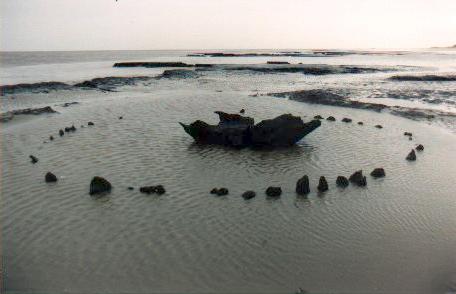 Photograph
� John Sayer 1999
Photograph
� John Sayer 1999Free preview of our Stone
Circles CD-ROM in the new Stone Circle Shop
Megalithic Mysteries - England Navigation:
 Photograph
� John Sayer 1999
Photograph
� John Sayer 1999
Read an extract from Seahenge - A Contemporary
Chronicle by Matthew Champion
| Seahenge cartoon by Lawrence
Moore
|
This site of international importance, formed by 55 oak timber posts completely encircling an upturned oak tree, has generated much public and media interest since its discovery was announced in January 1999. The beach on which it was found is a Site of Special Scientific Interest (SSSI) and the wildlife that feeds and breeds there is of international importance.
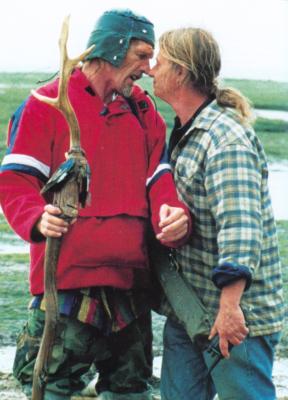 To
much local and national controversy, English Heritage decided that the best option for the
future of the 4000 year-old timber circle at Holme-next-the-Sea in Norfolk was to record
fully the site, then lift and analyse the upturned tree mark and circle of timber posts.
The whole structure, lying on the shore line of the dynamic Norfolk coast, was at risk of
being severely damaged by the sea and visitor pressure. Valuable information about the
Bronze Age period would have been lost forever.
To
much local and national controversy, English Heritage decided that the best option for the
future of the 4000 year-old timber circle at Holme-next-the-Sea in Norfolk was to record
fully the site, then lift and analyse the upturned tree mark and circle of timber posts.
The whole structure, lying on the shore line of the dynamic Norfolk coast, was at risk of
being severely damaged by the sea and visitor pressure. Valuable information about the
Bronze Age period would have been lost forever.
The timber posts were transferred to Flag Fen, near Peterborough, the archaeological centre based on the site of a unique Bronze Age religious complex. The laboratories at Flag Fen specialise in the study of prehistoric timber. The posts have been submerged in water tanks to prevent them from deterioration.
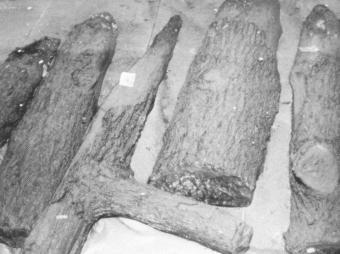 Clear
tool marks have provided important information on Early Bronze Age wood working and
construction methods. This is the first time that well preserved tool marks from a
complete Early Bronze Age site have been be studied in Britain.
Clear
tool marks have provided important information on Early Bronze Age wood working and
construction methods. This is the first time that well preserved tool marks from a
complete Early Bronze Age site have been be studied in Britain.
Access: Not accessible. There is controversy as to whether the timbers should be permanantly displayed, or returned to the sea.
Rating: General Impression 5, Ambience 3, Access 0
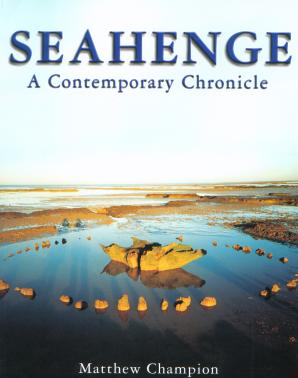 The actions of the sea and
sand upon the peat layers at Hoime Dunes are most curious. As the tides roll in over the
area of exposed peat the waters carry with them thousands of particles of sand. It is this
sand, suspended in the water as it rolls back and forth, that is actually responsible for
bringing many of the new objects to light. As it washes back and forth over the delicate
peat it acts very much like sand paper; scouring away a thin layer of peat particles each
time. Storm tides and heavy weather only add to this effect, breaking off larger chunks of
peat and washing it out to sea. Gradually, over a period of months, or even years, the
landscape that has been built up by time is gradually being stripped back layer by layer.
As each new area of peat is eroded a strange new landscape is emerging; a landscape from
our distant past.
The actions of the sea and
sand upon the peat layers at Hoime Dunes are most curious. As the tides roll in over the
area of exposed peat the waters carry with them thousands of particles of sand. It is this
sand, suspended in the water as it rolls back and forth, that is actually responsible for
bringing many of the new objects to light. As it washes back and forth over the delicate
peat it acts very much like sand paper; scouring away a thin layer of peat particles each
time. Storm tides and heavy weather only add to this effect, breaking off larger chunks of
peat and washing it out to sea. Gradually, over a period of months, or even years, the
landscape that has been built up by time is gradually being stripped back layer by layer.
As each new area of peat is eroded a strange new landscape is emerging; a landscape from
our distant past.
It is within this peat layer that the original surface landscape that formed the very ground upon which Seahenge's builders stood is located. Gradually, the salt-marsh that they walked upon is coming to the surface and it is bringing with it some amazing discoveries. It is this marsh surface that first brought to light John Lorimer's axe head, then Seahenge itself, then the pottery sherds, animal bones and charcoal.
Now, as another autumn and winter has passed, the peat is beginning to reveal even more artefacts and, of profound significance, other timber structures. Seahenge was not alone; was not a single great find in an eroded landscape but rather the first great artefact from an emerging ancient landscape.
John Lorimer, in his many visits to the site, has actually watched the process happen. It is a sight that few men will ever really witness: nature itself revealing the past, piece by piece and layer by layer. As John has patiently observed as the months have passed the sea and sand have become the archaeologists, gradually bringing to light a four thousand year old landscape. The landscape of Seahenge's builders.
One of the first major features to be noticed by John, and subsequently by the archaeologists, was that there were areas in the surface where no peat was actually present. Instead there were long thin areas covered with small rounded stones. These stones, rather than being part of the original marsh, are actually the beds of ancient streams and small rivers that ran through the salt-marsh on their way to the sea. The first of these ancient and shallow river beds that came to light actually ran between the site of the circle and the peat scarps; the peat scarps that had been producing animal bones and other 'spirit goods'.
Then, in the area of the peat scarp itself, on the other side of the old river bed from the circle, a second timber structure began to emerge. Although much smaller than the original circle this new structure was also obviously man made. The structure was also much simper than the circle. All it consisted of was two lengths of timber, logs that had been worked by axes, that were laid on their side next to each other. The upper surfaces had been squared off and the whole was surrounded by what appeared to be a small wickerwork fence.
The presence of the wicker work surrounding the object immediately aroused suspicions that it may have been some sort of fish trap. However, further analysis revealed that the wickerwork fence was actually constructed of oak withies. Wicker-work and basket-work can be done using a variety of types of timber. Willow, hazel and even honeysuckle will all work well and stand up to the rigours of time; oak, however, will not and will quickly become brittle as it naturally dries out in the atmosphere. The use of oak in the wicker fence clearly points to it being used not for any practical purpose but rather for its ritual significance.
The use of specific timbers, and most especially oak, in sites of ritual and ceremonial importance is well recorded among many ancient peoples. The Celtic peoples worship of the oak tree is well attested both in Britain and on the continent and their word for a sanctuary (Nemeton) appears to be identical in origin to the Latin Nemus, or wooded grove. The German tribes were particularly strong in their worship of trees and had harsh laws that protected them. Any man discovered to have removed the bark from a living tree was to have his navel cut out and nailed to the area from which he had stripped the bark. The unfortunate culprit was then forced to go round and round the tree until his entrails were wound around the trunk; the mans skin and guts replacing the lost bark, a life for a life.
The Scandinavians also held trees in particular reverence. The Finnish tribes were known to have carried out their acts of worship in sacred groves until relatively recent centuries. Their sacred sites were almost always surrounded by a fence, past which no woman could go, and consisted of a clearing surrounded by a few sacred trees. It is also recorded that these trees were used to hang up the skins of their sacrificial victims and that no tree within the grove should be harmed in any way. Also in Scandinavia, at Upsala in Sweden, there was a very well known, and reputedly powerful, sacred grove in which every tree was regarded as divine.
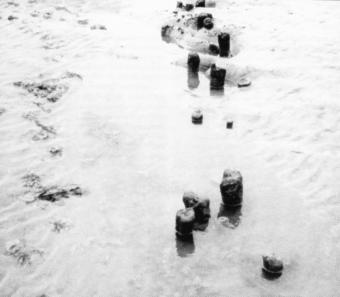 Alongside the discovery of the two tree trunks within the wicker-work
oak fence other timber artefacts and structures began to emerge from the peat beds at
Holme. Across the surface of what would have been salt-marsh 4000 years ago the
archaeologists found what appeared to be other timbers. These timbers, far from being just
scattered remains, were laid out in a series of long lines and, in conjunction with wooden
planks, some of which have also been discovered, may well have been pathways, or
causeways, across the marsh.
Alongside the discovery of the two tree trunks within the wicker-work
oak fence other timber artefacts and structures began to emerge from the peat beds at
Holme. Across the surface of what would have been salt-marsh 4000 years ago the
archaeologists found what appeared to be other timbers. These timbers, far from being just
scattered remains, were laid out in a series of long lines and, in conjunction with wooden
planks, some of which have also been discovered, may well have been pathways, or
causeways, across the marsh.
The causeways, though just as likely to have been of a purely practical nature, may well have been ceremonial walkways between the timber structures. Some appear to point in the direction of known structures while others veer off across the marsh: heading no one knows where. It is possible that they connect the Seahenge site with other similar sites, such as the circle discovered by Geoff Needham in the late 1970s about half a mile along the beach. Perhaps there are more such structures still waiting to come to light, or perhaps, like Geoff Needham's circle, they have already been lost to the sea.
John Lorimer, amongst others, believes he does know what these other finds signify and in what way they join to form a whole. 1 imagine', writes John, 'the cadaver was first positioned upon the two logs and rites were held before they were ferried across the river to the circle. Once at the circle, having crossed the marsh on the causeways and waded through the river, the body was then placed on the central tree stump. After it had decomposed the bones were then removed and either buried or cremated. During the ceremony the spirit goods would be ritually broken and buried, their spirits going on to join the deceased in the afterlife'.
Although only speculation John Lorimer's ideas are based upon sound evidence and are tentatively shared by both historians and archaeologists. It is quite possible to conclude that what is appearing out of the peat at Holme is something more than just a simple circle constructed of ancient timbers. It may well be that Seahenge, Geoff Needham's circle, the wickerwork enclosure, the causeways, the riverbeds and the spirit goods all form part of one massive spiritual monument. Like Stonehenge, Avebury and the stone avenues that cover the Wiltshire countryside the area around Holme may have been just as large and just as important. Perhaps it was the religious site for the Bronze Age peoples of East Anglia: a place where they carried their important dead. A ritualistic landscape where the sea met the land and the bodies were ferried across to the sacred island in the marsh; an isle of the dead.
This is, of course, nothing but speculation. It is quite possible that future finds and further evidence will point to an entirely different conclusion. It may well be that the site proves to be nothing more than a place of funerary ritual, with no more spiritual significance that a modern hospital crematorium. However, at this moment in time it appears to be emerging as something more than just a place of crude biological death. Perhaps the site, against all my initial scepticism, really is a spiritual centre. Perhaps the Peddars Way, the ancient and mysterious trackway that stretches across the Norfolk landscape, does indeed lead somewhere after all. It leads to Holme.
Author's Note: The timber features described above are no longer visible at Holme, having been excavated or washed away.
Order a copy of the Seahenge book now.
Thanks to Matthew Champion and John Sayer, and not forgetting Lawrence Moore for the excellent cartoon!
10th October 2000: Some news about Seahenge itself from a reliable source.
Officials at Flag Fen after one year now say they have completed their investigation and want to release the timbers and send them back to Norfolk. The Rural Life Museum at Gressenhall is to accept Seahenge for a two to five year programme of preservation work before returning it to West Norfolk, if a venue can be found and an authority to take responsibility. Readers may be interested to read Francis Pryor's statements of last August on the Flag Fen pages. There is, as yet, no report available from the work done at Flag Fen and it is still not clear what preservation technique, if any, will be used.
Owner of Seahenge, the le Strange Estate who agreed to the excavation, does not wish to retain ownership and has approached the West Norfolk Borough Council as the most likely authority to take control, but the Councillors are reluctant to do so and consider that responsibility should be undertaken by the county council's Museums and Archaeological Service. Particularly in view of it's role in the original excavation.
The Norfolk Museums and Archaeological Service and English Heritage, both of whom were involved in the decision to excavate the monument, have said they would like to see the timbers returned to the County but only after the funding and responsibility have been resolved.
Holme Parish Council Chairman Geoff Needham has said that formation of a Charitable Trust with responsibility for Seahenge has been discussed but he says, "No one, as yet, wants to join such a Trust."
What's your opinion on moving the circle? Join the Stones Mailing List and take part in the debate.
Megalithic Mysteries - England Navigation:
|
Free use of images:
The above photographs are � Andy Burnham unless otherwise stated
You are free to use up to
20 of my photographs on your web site provided that:
1 - they are not images credited to another photographer
2 - you put a link to www.megalithic.co.uk
and credit Andy Burnham near every image used
For images credited to
other photographers please ask permission by contacting me
for their e-mail address.
Using material in any other way without the author's permission is strictly
forbidden.